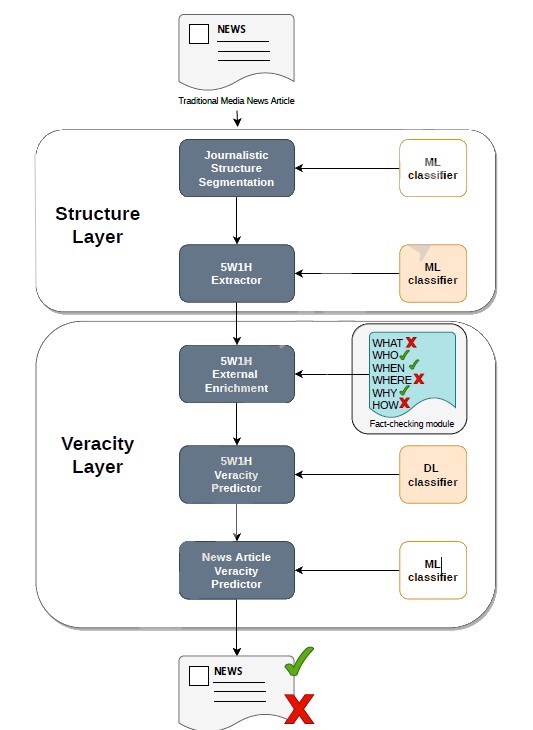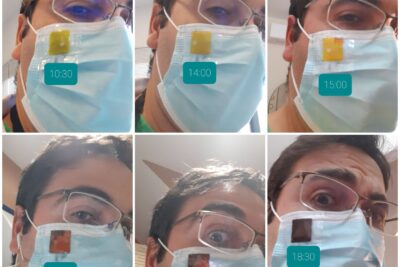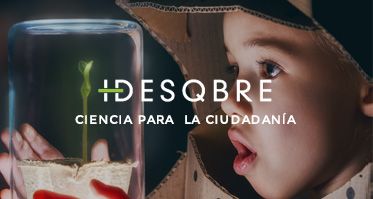Development of a ‘smart’ system for fake news detection
A research team from the University of Jaén and the University of Alicante has tested a model based on artificial intelligence that determines the truthfulness of information in digital media. Using this tool, both journalists and end users will be able to define the credibility of a text.
A research team from the universities of Jaén and Alicante has created an application that automatically analyses news stories and determines their truthfulness with a high degree of accuracy. Although the model is still in the testing phase, it is proposed as a useful tool for filtering the vast amount of information that reaches journalists and private readers every day.
To identify fake news, scientists have developed machine learning-based false news and misinformation credibility inference models. These artificial intelligence techniques allow the system to analyse the news on two levels to detect whether there are inconsistencies in the content and whether the structure matches what any publication with journalistic rigour should possess.

The system analyses the structure of the published news item taking into account traditional journalistic standards: the 5W+H rule and the inverted pyramid.
In the journal Expert Systems with Applications, the researchers have published an article entitled ‘Exploiting discourse structure of traditional digital media to enhance automatic fake news detection’ in which they present the prototype of a ‘fake news’ detector for websites. This tool aims to offer greater confidence to the reader and to provide journalists with new tools that allow them to distinguish between different pieces of information.
The system analyses the structure of the published news item taking into account traditional journalistic standards: the 5W+H rule and the inverted pyramid. These references are based on the fact that a rigorous news story should contain information that answers the six basic questions (what, when, where, who, why and how) and should be presented in descending priority from what is most important to the finer details. «The structure of a publication gives clues as to whether it has a journalistic basis or whether it is instead simulating a real news story,» Fundación Descubre was told by Miguel Ángel García, researcher at the University of Jaén and one of the authors of the article.
From the analysis of natural language, experts develop an algorithm that detects information that does not match this structure. These calculations are based on techniques of what is known as machine learning, whereby the system ‘learns’ as it accumulates more and more data.
In addition, the machine is capable of processing thousands of simultaneous data in seconds, something that a person could not do. «Thus, journalists can compare and contrast sources, detect incorrect structures, viral contents or inconsistencies between the headline and the body of the news immediately and automatically. The end user will also have clues as to whether the news they read meets certain standards or not,» adds Estela Saquete, researcher at the University of Alicante and another author of the article.
Analyse, detect and highlight to alert
The scientific team of ‘Intelligent Information Access Systems’ (SINAI), of the University of Jaén, and the ‘Natural Language Processing and Information Systems Group’ (GPLSI) of the University of Alicante, carried out the tests with a dataset in Spanish consisting of more than 200 articles focused on health issues, of special relevance nowadays due to the numerous fake news circulating about COVID-19.
The system is based on deep learning, which creates computational models composed of multiple layers of data processing. In this particular work, the experts define two layers. On the one hand, the structure of the news item, and on the other, the storyline. In this way, the machine predicts not only the credibility of the form, but also of the content.
In addition, the researchers have applied a new scheme for data processing, known as fine-grained annotation, which consists of establishing labels for news items. These tag sets apply to all possibilities, even if the differences are small. This provides a detailed description of each text at both levels.
Each label carries a set of attributes that provide information beyond linguistic aspects to include the verification of facts, semantic relationships between elements or contextual features. It even refers to aspects related to the emotional charge that a piece of writing may contain and that distance it from the objectivity that should characterise a real news story.
The experts’ objective is to obtain an application that automatically marks the text of a news item while it is being read and that flashes up those fragments that may be false, pointing out the references with other similar texts that allow their truthfulness to be verified.
This research has been developed through the project ‘LIVING-LANG: Modelling the behaviour of digital entities through Human Language Technologies’ of the Spanish Ministry of Science and Innovation, and the project ‘SIIA: Human Language Technologies for an inclusive, egalitarian and accessible society’ of the Comunidad Valenciana.
Spanish’s version: Desarrollan un sistema ‘inteligente’ que detecta noticias falsas
References
Alba Bonet Jovera, Alejandro Piad Morffis, Estela Saquete, Patricio Martínez Barco and Miguel Ángel García Cumbreras.‘Exploiting discourse structure of traditional digital media to enhance automatic fake news detection’. Expert Systems with Applications. 2021
Más información:
#CienciaDirecta, agencia de noticias de ciencia andaluza, financiada por la Consejería de Transformación Económica, Industria, Conocimiento y Universidades de la Junta de Andalucía.
Teléfono: 954 232 349
Additional documentation
Miguel Ángel García, author of the article
Últimas publicaciones
Un equipo de investigación de la Universidad de Almería y la Universidad Nacional de Mar del Plata en Argentina ha encapsulado proteínas activas extraídas de los residuos de la industria pesquera. Con esta forma esférica, mantienen su actividad y estabilidad durante más de dos meses para emplearse como base en quitamanchas o nutrición animal.
Sigue leyendoSe trata de un sistema innovador de indicación visual del tiempo de exposición en mascarillas de protección facial. Una invención que ha sido desarrollada el grupo de investigación OMEGAs, liderado por el profesor del Centro de Nanociencia Tecnologías Sostenibles (CNATS) de la Universidad Pablo de Olavide (UPO) de Sevilla José María Pedrosa. También han participado los investigadores Javier Roales y David Rodríguez, en colaboración con el empresario sevillano José Antonio Rodríguez, quien ya ha iniciado los primeros pasos para su comercialización.
Sigue leyendoEstos resultados se desprenden de una investigación liderada por el Consejo Superior de Investigaciones Científicas. Aunque el estudio se ha realizado en ratones y no es directamente aplicable a humanos, los científicos consideran que se trata de una vía de trabajo prometedora. El trabajo incluye, además, un estudio observacional en humanos que revela que las personas con mayor fuerza muscular, mejor perfil de triglicéridos y menor propensión a sufrir algunas alteraciones neurocognitivas eran precisamente quienes tenían potenciados algunos de los mecanismos sobre los que actúan estos compuestos del ajo.
Sigue leyendo





